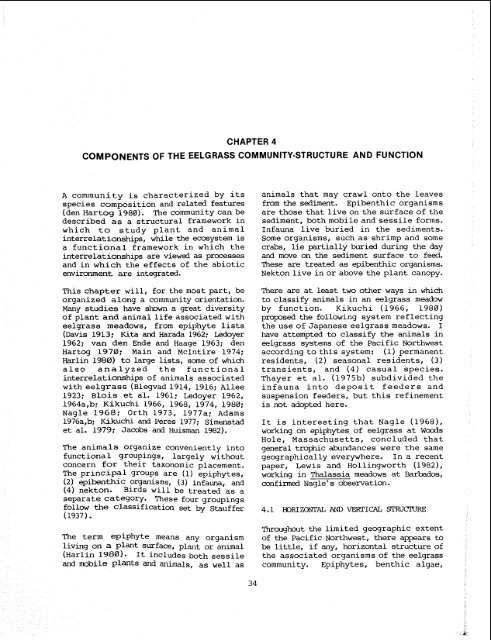The ecology of eelgrass meadows in the Pacific Northwest: A ...
The ecology of eelgrass meadows in the Pacific Northwest: A ...
The ecology of eelgrass meadows in the Pacific Northwest: A ...
- No tags were found...
Create successful ePaper yourself
Turn your PDF publications into a flip-book with our unique Google optimized e-Paper software.
CHAPTER 4<br />
COMPONENTS OF THE EELGRASS COMMUNITY-STRUCTURE AND FUNCTION<br />
A community is characterized by its<br />
species composition and related features<br />
(den Hartog 1980). <strong>The</strong> community can be<br />
described as a structural framework <strong>in</strong><br />
which to study plant and animal<br />
<strong>in</strong>terrelationships, while <strong>the</strong> ecosystem is<br />
a functional framework <strong>in</strong> which <strong>the</strong><br />
<strong>in</strong>terrelationships are viewed as processes<br />
and <strong>in</strong> which <strong>the</strong> effects <strong>of</strong> <strong>the</strong> abiotic<br />
environment are <strong>in</strong>tegrated.<br />
animals that may crawl onto <strong>the</strong> leaves<br />
from <strong>the</strong> sediment. Epibenthic organisms<br />
are those that live on <strong>the</strong> surface <strong>of</strong> <strong>the</strong><br />
sediment, both mobile and sessile forms.<br />
Infauna live buried <strong>in</strong> <strong>the</strong> sediments.<br />
Some organisms, such as shrimp and some<br />
crabs, lie partially buried dur<strong>in</strong>g <strong>the</strong> day<br />
and move on <strong>the</strong> sediment surface to feed.<br />
<strong>The</strong>se are treated as epibenthic organisms.<br />
Nekton live <strong>in</strong> or above <strong>the</strong> plant canopy.<br />
This chapter will, for <strong>the</strong> most part, be<br />
organized along a community orientation.<br />
Many studies have shown a great diversity<br />
<strong>of</strong> plant and animal life associated with<br />
<strong>eelgrass</strong> <strong>meadows</strong>, from epiphyte lists<br />
(Davis 1913; Kita and Harada 1962; Ledoyer<br />
1962; van den Ende and Haage 1963; den<br />
Hartog 1970; Ma<strong>in</strong> and McIntire 1974;<br />
Harl<strong>in</strong> 1980) to large lists, some <strong>of</strong> which<br />
also analyzed <strong>the</strong> functional<br />
<strong>in</strong>terrelationships <strong>of</strong> animals associated<br />
with <strong>eelgrass</strong> (~legvad 1914, 1916; Allee<br />
1923; Blois et al. 1961; Ledoyer 1962,<br />
1964a,b; Kikuchi 1966, 1968, 1974, 1980;<br />
Nagle 1968; Orth 1973, 1977a; Adams<br />
1976a,b; Kikuchi and Peres 1977; Simenstad<br />
et al. 1979; Jacobs and Huisman 1982).<br />
<strong>The</strong> animals organize conveniently <strong>in</strong>to<br />
functional group<strong>in</strong>gs, largely without<br />
concern for <strong>the</strong>ir taxonomic placement.<br />
<strong>The</strong> pr<strong>in</strong>cipal groups are (1) epiphytes,<br />
(2) e~ibenthic organisms, (3) <strong>in</strong>fauna, and<br />
(4) nekton. Birds will be treated as a<br />
separate category. <strong>The</strong>se four group<strong>in</strong>gs<br />
follow <strong>the</strong> classification set by Stauffer<br />
(1937).<br />
<strong>The</strong>re are at least two o<strong>the</strong>r ways <strong>in</strong> which<br />
to classify animals <strong>in</strong> an <strong>eelgrass</strong> meadow<br />
by function. Kikuchi (1966, 1980)<br />
proposed <strong>the</strong> follow<strong>in</strong>g system reflect<strong>in</strong>g<br />
<strong>the</strong> use <strong>of</strong> Japanese <strong>eelgrass</strong> <strong>meadows</strong>. I<br />
have attempted to classify <strong>the</strong> animals <strong>in</strong><br />
<strong>eelgrass</strong> systems <strong>of</strong> <strong>the</strong> <strong>Pacific</strong> <strong>Northwest</strong><br />
accord<strong>in</strong>g to this system: (1) permanent<br />
residents, (2) seasonal residents, (3)<br />
transients, and (4) casual species.<br />
Thayer et al. (1975b) subdivided <strong>the</strong><br />
<strong>in</strong>fauna <strong>in</strong>to deposit feeders and<br />
suspension feeders, but this ref<strong>in</strong>ement<br />
is not adopted here.<br />
It is <strong>in</strong>terest<strong>in</strong>g that Nagle (1968),<br />
work<strong>in</strong>g on epiphytes <strong>of</strong> <strong>eelgrass</strong> at Woods<br />
Hole, Massachusetts, concluded that<br />
general trophic abundances were <strong>the</strong> same<br />
geographically everywhere. In a recent<br />
paper, Lewis and Holl<strong>in</strong>gworth (1982),<br />
work<strong>in</strong>g <strong>in</strong> Thalassia <strong>meadows</strong> at Barbados,<br />
confirmed Nagle's observation.<br />
4.1 HORIZONTAL AND VEHTICAL STRUCTURE<br />
Throughout <strong>the</strong> limited geographic extent<br />
<strong>The</strong> term epiphyte means any organism <strong>of</strong> <strong>the</strong> <strong>Pacific</strong> <strong>Northwest</strong>, <strong>the</strong>re appears to<br />
liv<strong>in</strong>g on a plant surface, plant or animal be little, if any, horizontal structure <strong>of</strong><br />
(Harl<strong>in</strong> 1980)- It <strong>in</strong>cludes both sessile <strong>the</strong> associated organisms <strong>of</strong> <strong>the</strong> <strong>eelgrass</strong><br />
and mobile plants and animals, as well as community. Epiphytes, benthic algae,

















